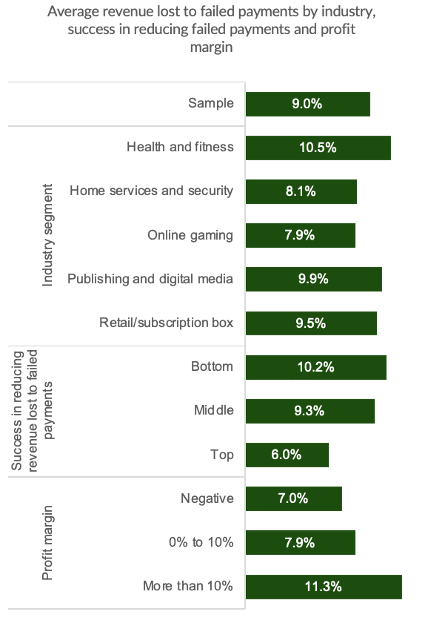
Retail has enjoyed some spending bumps over the past few months, and grocers are still seeing business, even as many shoppers trade down. However, the direct-to-consumer (D2C) sector has had a particularly tough time staying afloat as consumers continue to belt-tighten, especially when it comes to segments considered discretionary. A main challenge for subscription company profitability is failed payments, found to be responsible for half of all D2C customer loss.
With these headwinds, it may be understandable why 39% of subscription companies are hesitant to establish new systems to analyze, track and resolve failed payments. Perceived complexity was cited as a main cause.
However, there’s never been anything easy about running a business, especially these days. Being deterred because of anticipated difficulty may be a barrier to overcome, given the rate of revenue loss for certain subscription segments stemming from failed payments. These rates are noted in proprietary data prepared for the March PYMNTS collaboration with FlexPay, “Tracking Failed Payments.”

Health and fitness subscription revenue on average is most affected by failed payments, followed by another segment many might view as discretionary, publishing and digital media, at 9.9%. Although some subscription providers believe tracking failed payments is a “nice to have,” PYMNTS finds it may be a necessary function when it comes to revenue retention. Companies across all sectors are cutting back on innovation investments, but when it comes to ROI, investing in payments software may be a subscription company’s best bang for its buck. Of surveyed subscription companies, D2Cs that track and analyze failed payments lose 37% less revenue and recover 43% more payments than those who don’t.
In an interview with PYMNTS’ Karen Webster, FlexPay CEO Darryl Webster described the importance for subscription companies to address failed payments. He calls it “one of the most significant positive impacts on the lifetime value of your business because you’re recovering a customer that would have been lost to involuntary churn, and not just recovering that transaction. I think that’s why we see top performers tracking failed payments much more than any other KPI or unit economic. It’s because they’ve zeroed in on how this punches way above its weight. This is a hidden sort of issue that is a massive lever in unlocking value.”
Health and fitness subscriptions not only have to worry about sector-wide retention loss as customers continue to dial back spending, but also increased competition in an already crowded market. Solutions towards stemming failed payments through software or other platform implementations exist, and having up to 10% of revenue be saved or lost has make-or-break potential for most businesses.
Segments facing high rates of revenue loss could turn the tide of failed payments and ensuing customer loss implementing these innovations. And that alone may be worth any implementation headaches.